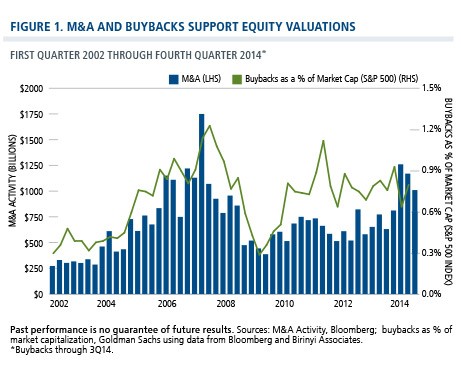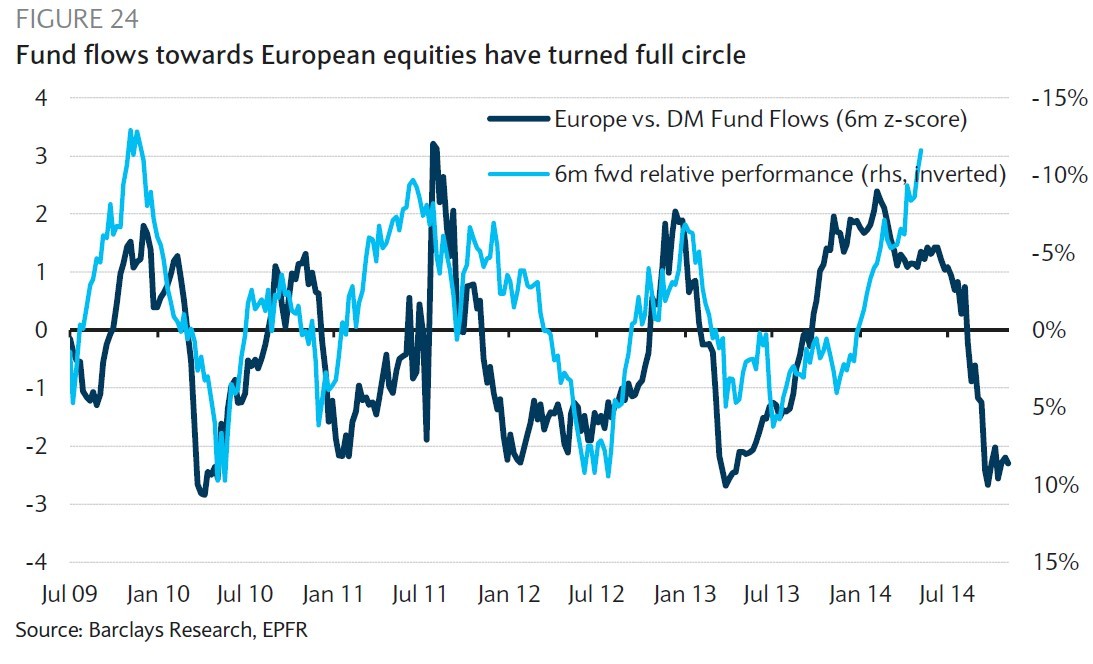Stock Market 2015 Equity And Bond Valuations
Post on: 5 Июль, 2015 No Comment

Stock Market Outlook: Same Song, Slightly Different Arrangement by Jeffrey Knight, CFA, ColumbiaManagement
- We are as convinced as ever that equities have a significant advantage over other asset classes based on valuation.
- Managing the risk of simultaneous drawdown across asset classes requires a process to actively de-risk portfolios and a methodology for diagnosing the conditions to trigger such a step.
- To manage risk and stabilize portfolio values in case equities do not perform well, we favor non-traditional diversifiers, explicit downside hedges and a methodology for active risk reduction.
Note: Look for Jeff in the December 13 edition of Barron’s for comments on his 2015 outlook. For the pdf of this article click here.
The other day, my teenage daughter asked how my passion for music began. I described for her my first record player, a Kenner “Close ’n Play.” This aptly named device would play your chosen 45 rpm record when you closed its cover and stop playing when you opened it. I loved my Close ’n Play, and I would listen to songs like “Can’t Buy Me Love” over and over again on it. It even had a handle, so I could carry my music from one room to another, like an iPod.
Unlike an iPod though, the Close ’n Play would travel with only one song. “Can’t Buy Me Love” in the kitchen. “Can’t Buy Me Love” in the basement. In the early 1970s there was no Pandora Media Inc (NYSE:P ) or Spotify or Rhapsody.
As I sit down to compose an outlook for 2015, it occurs to me that since 2009, the financial markets have been more like a Close ’n Play than an iPod — low expected returns from safe assets and stocks offering the best chance of any meaningful investment gains. Just like last year and the year before.
What’s different in 2015?
As stationary as market conditions have felt lately, circumstances are always evolving. For 2015, while the essential elements of our outlook remain in place, we highlight two important changes in the market environment:
- The relative value of global equities vs. global bonds actually improved during 2014.
- Monetary policy around the globe has become desynchronized, with the U.S. Federal Reserve (the Fed) contemplating rate hikes, while the European Central Bank (ECB) and the Bank of Japan (BOJ) intensify their monetary stimulus programs.
In this article, I will detail the implications of these conditions for investment strategy. In our view, while equities will most likely continue to dominate, the complex interactions of today’s conditions elevate the role of dynamic risk management. We argue that investors will need a cross-asset surveillance methodology to detect tactical threats.
Equity hegemony in action
For several years, we have argued that equities have a significant advantage over other asset classes based on valuation. With short-term interest rates near zero and government bond yields around the world at historic lows, the comparison between stocks and bonds based on forward-looking expected returns has been very lopsided. Market returns in 2014 underscore the valuation advantage that equities offer. (Exhibit 1)
Exhibit 1: In 2014, equities outperformed bonds again

For this comparison, we use global returns to represent equities but only U.S. returns to represent bonds. This is an unfair comparison because the equity index reflects a loss of return due to currency translation effects, while the domestic bond index does not. We make the comparison to emphasize that today, a margin of safety exists in favoring stocks over bonds.
When we analyze these returns closely, we find significant evidence of this margin of safety. With respect to bonds, the Barclays PLC (NYSE:BCS ) (LON:BARC ) Aggregate Bond Index offered a yield-to-worst of 2.5% as 2014 began. This means that investors could have expected roughly a 2.5% return for the year if bond prices had stayed constant. The fact that the index has returned more than double its promised yield reveals that bond prices have not stayed constant, they have risen. Few investors expected bond prices to rise in 2014. Therefore, bonds (represented by the Barclays Aggregate) delivered more return than expected. Global stocks, on the other hand, delivered less than expected.
Exhibit 2: Equity returns lagged the change in corporate earnings
Exhibit 2 breaks down global equity returns into the portion attributed to corporate earnings growth and the portion attributed to changes in the price/earnings (P/E) multiple (the multiple of earnings that investors have paid for equities). For 2014, returns for the MSCI All Country World Index (MSCI ACWI) lagged the change in corporate earnings for the year. The green bars below the X axis illustrate that P/E multiples actually contracted in 2014 for the first time in years.
These comparisons reveal the powerful valuation advantage that equities enjoy today. Our proxy for equities, the MSCI ACWI, outperformed our proxy for bonds, the Barclays U.S. Aggregate Bond Index, even though:
- The equity index includes substantial losses related to currency.
- The equity index faced a headwind from falling multiples.
- The bond index enjoyed an unexpected tailwind from rising bond prices.
This is what we mean by the phrase “equity hegemony.” With the relative valuation so favorable for equities, they have delivered superior returns even when a variety of influences conspired against them.
The comparison favors equities more strongly for 2015
Exhibit 3: Equity markets offer higher expected risk-adjusted returns than bonds
Exhibit 3 depicts our valuation landscape for selected global assets as 2015 begins. The graph plots the expected return vs. risk for selected assets around the world, based on Columbia Management proprietary estimates. For each asset, the expected return (proxied by yield-to-maturity for bonds and by implied cost of equity capital for stocks) is plotted against the product of volatility and correlation to world equities. By incorporating correlation, we give credit to assets that offer a diversification benefit by adjusting the asset’s volatility downward as long as it has a correlation of less than one to world stocks. We believe this adjustment helps in the direct comparison of stocks and bonds from a risk-adjusted return standpoint.
The chart also shows a “line of best fit” through all of the points, which visually represents the compensation that investors get for adding risk by increasing allocations to the assets on the right of the zero point. Today, that line is quite steep, indicating a high marginal reward to investors willing to increase portfolio volatility. For the past several years, the best-fit line has been notably steeper than its typical level. This is noteworthy, as our adjusted volatility measure, in effect, gives an advantage to bonds and should serve to flatten the line of best fit. This cross-asset analysis was key to our assessment that global equities enjoy a valuation advantage.
Exhibit 4: The steeper 2014 best-fit line suggests higher expected returns for stocks
Exhibit 4 removes all of the individual markets and simply plots our line of best fit against the same line as it stood at the beginning of 2014. This visual reveals the surprising way relative valuation has evolved over the past year. The left side of the line has dropped, indicating that the expected returns from bonds have fallen, while the right side of the line has risen, indicating an increase in expected returns for global stocks*. Amazingly, in this era of equity hegemony, the comparison has become even more favorable for equities going forward.
Monetary policies diverge
The Fed has given strong signals that economic growth in the United States has reached self-sustaining momentum and no longer needs unconventional efforts to support the expansion. The withdrawal and suspension of large-scale asset purchases was only the first step in the evolution toward policy normalization. In 2015 we expect to see a change in forward guidance and, most likely, the first interest rate increase in years.
These actions stand in stark contrast with the direction of the monetary policies of other central banks as they double down on efforts to support growth and avoid deflation. The Bank of Japan has announced its intention to increase both qualitative and quantitative easing on an enormous scale, expanding purchases of Japanese government bonds (JGBs), exchange-traded funds (ETFs) and real estate investment trusts (REITs). They intend to coordinate this with government pension investment fund purchases by shifting into riskier assets through sales of JGBs.
With evidence of deterioration on both the economic and inflation front, the European Central Bank also plans to take bolder actions. These include increased purchases of asset-backed securities and covered bonds in both the primary and secondary market, together with the long-term refinancing operations that will steer the ECB’s balance sheet higher by €1 trillion. The latest to jump on the bandwagon was the People’s Bank of China (PBOC), which cut its benchmark interest rate for the first time in over two years to support private sector investment, as targeted liquidity injections have had minimal effect on sinking economic growth.
Markets reacted very positively to the announcements from BOJ, ECB and PBOC, as the rush














